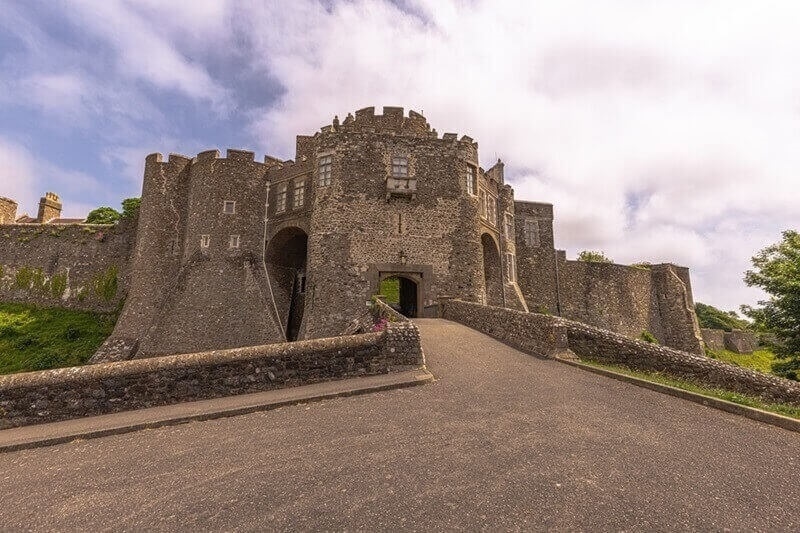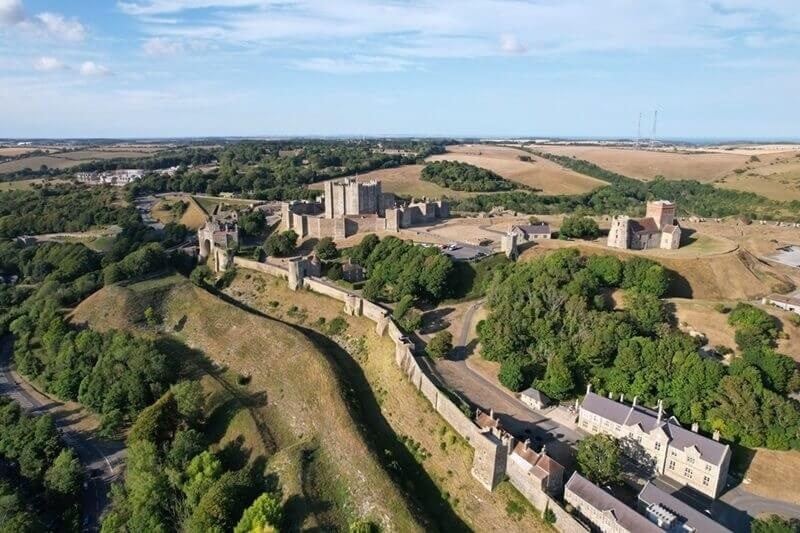
Under the towering cliffs of southeastern England lies a secret world carved in chalk, a location where shadows whisper of strategy and defiance for survival. We are talking about Dover Castle's tunnels, a labyrinthine stronghold that helped shape the course of World War II. These tunnels were not merely passageways underneath the mountains; instead, there were war rooms, hospitals, and command centers. The heartbeat of Britain’s resistance pulsed in these tunnels, completely safe from the Luftwaffe’s bombs above.
This blog will delve into the depths of Britain's secret fortress and explore the high-stakes decisions that were made here during WWII.
Before we enter the subterranean domain, it’s essential to grasp the castle’s gravity. The Dover Castle is not just any historical monument and it is often referred to as the Key to England. Underneath the White Cliffs, this fortress has protected Britain’s shores since the 11th century. Kings, queens, and conquerors all passed through, from William the Conqueror to Henry VIII, but its most critical transformation occurred centuries later during WWII.
Essential Reading: The Underground Tunnels of Dover Castle: Exploring History
Carved into the chalky hillside, Dover Castle’s tunnels were developed during the Napoleonic Wars to house troops and store weapons. However, it was during the Second World War that this fortress became formidable.
Britain braced for a new kind of warfare by 1939. Dover Castle, which was less than 25 miles from Nazi-occupied France, was vulnerable. It forced the British government to decide to command one of the most daring operations in military history.
The tunnels were expanded, electrified, and transformed into a complete underground military base. The three primary functions defined them perfectly:
This made these tunnels one of Britain’s best-kept wartime secrets.

Imagine dim corridors echoing with hurried footsteps, urgent voices around flickering map lights, and the constant buzz of teleprinters. These were the secret wartime tunnels of Dover, a place of relentless vigilance.
The tunnels' defining moment came in May 1940. When British and Allied forces were cornered at Dunkirk and trapped between advancing German divisions and the sea, a defeat seemed was inevitable.
But beneath Dover Castle, Vice Admiral Bertram Ramsay hatched Operation Dynamo, the daring evacuation of more than 330,000 soldiers across the English Channel. This was done from the Dover Castle secret wartime tunnels and relied on every available vessel.
Thousands of soldiers were rescued in less than ten days, under relentless fire and air attack. This evacuation was a miracle that was forged in the darkness.
This wasn’t just military strategy; it was existential salvation.
As you descend into the tunnels today, time seems to pause. The museum exhibits echo with the static of 1940s radios, the glow of old lamps guiding your way. Here’s what you will find inside the fortress:
This room was once sealed off from the world because this is where maps were drawn, orders shouted, and lives weighed against impossible odds. It was staffed 24/7 to coordinate naval maneuvers and tracked enemy movement across the channel.
Another chilling section is the wartime hospital, a stark reminder of the human cost of war. Stretcher bays, surgical rooms, and recovery wards tell the story of soldiers rescued from the front, some surviving, others not.
Nurses operated in near-total darkness during air raids, guided by training and instinct. The claustrophobic tunnels carried the moans of the wounded and the silence of the fallen.
Encrypted messages were dispatched from these rooms via wireless sets and switchboards. Ciphers were decoded, weather reports analyzed, and enemy broadcasts intercepted.
These tunnels weren’t just strategy—they were information powerhouses.
Check Out: Dover Castle's History: The Legacy of a British Icon
It’s easy to forget that some of the 20th century’s most pivotal moments were decided underground, in tight rooms lined with chalk and steel.
The decision to launch Operation Dynamo saved thousands of British Army soldiers from getting annihilated. It also rallied the nation’s morale and prompted Winston Churchill’s famous ‘We shall fight on the beaches’ speech.
The Dover Castle’s tunnels became the command hub for coastal defenses after Dunkirk. Artillery placement, anti-aircraft coordination, and naval patrols were all directed from these subterranean halls.
Dover Castle's tunnels monitored the Luftwaffe movement during the Battle of Britain. Radar and intelligence were funneled here and informed the RAF responses across the south coast.
In short, the secret wartime tunnels Dover were not just shelters but were strategic epicenters.
The war ended, but the tunnels' usefulness didn't. During the Cold War, they were refurbished as a potential regional government headquarters in the event of a nuclear attack. Bunk beds, rations, and filtered air systems were installed.
Though never used in a real crisis, their existence remained classified for decades. Only in recent years have visitors been able to explore these passages and grasp their Cold War significance.
Now open to the public, Dover Castle’s tunnels offer immersive tours—complete with archival footage, interactive exhibits, and atmospheric soundscapes.
Walking through them is more than a history lesson—it’s a visceral connection to the fear, brilliance, and resilience of those who fought an invisible war underground.
The stories created in Dover Castle’s tunnels still continue to inspire filmmakers and historians. From Christopher Nolan’s ‘Dunkirk’ to BBC war documentaries, the drama of these tunnels has echoed across the media.
Schools and universities study the site not just for military strategy but for its logistical genius and innovations in wartime communication.
In an age of digital warfare and satellite surveillance, there is something profoundly grounding about Dover’s subterranean command center. It reminds us about the different historical events that required people to make extremely brave decisions.
Dover Castle’s tunnels were not just a response to war. They were a sign of ingenuity and leadership. These tunnels displayed the massive strength of those who operated in the shadows to safeguard the future.
When you next gaze across the English Channel, remember what lies beneath your feet. Beneath Dover’s windswept cliffs are not just passageways, but the very arteries of wartime resistance.
The secret wartime Dover Castle’s tunnels tell a story of hope forged under pressure, of brilliant decisions made in the face of annihilation. Visiting them isn’t just sightseeing—it’s time travel to a moment when Britain stood on the edge, and turned back the tide.
History was not just written in palaces or parliaments—it was etched into chalk, deep beneath a fortress by the sea.
This content was created by AI